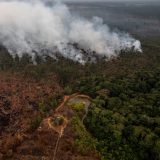Project Rondônia, an Update April 2021
Get an update from Amazonian expert Douglas Daly, Ph.D., who was the ground with local collaborators in Rondônia, the eye of the firestorm in the Brazilian Amazon that caused devastating forest loss.

Douglas C. Daly and collaborators
I worked on documenting the flora of the state of Acre in Amazonian Brazil over a period of 25 years, culminating in the publication of the First Catalogue of the Flora of Acre, Brazil, which documented 4000 species of plants and included a botanical history of the state and analyses of biogeography, common names, and contributions to conservation.
A natural outgrowth of the Acre project has been a geographical expansion that embraces all of the Southwestern Amazon, a distinctive flora that includes parts of Brazil, Peru, and Bolivia. The Acre team and I developed a consortium of herbaria based in Southwestern Amazonia that shares data and specimens, and we have been developing a website for this.
Within the SW Amazon initiative, I am concentrating my efforts on the state of Rondônia, Brazil, where I have replicated the Acre program, that is, partnering with the federal university there and investing in training, institution-building, scientific exchange, and of course botanical exploration and collecting throughout the state. Rondônia is quite a contrast to Acre in that it has many transitions to the cerrado (savanna woodland) vegetation characteristic of Central Brazil, as well as large areas of white-sand formations and two low mountain ranges that are virtually unexplored.
In order to call more attention to Rondônia, I am editing a collection of articles about various aspects of its flora, including botanical history, characterization of vegetation types, and new species, which will be published together in NYBG’s systematics journal, Brittonia.
Related project: Updating the First Catalogue of the Flora of Acre
Record-setting fires have created an environmental crisis in Amazonian Brazil. The loss of forest to these fires displaced people and animals, negatively effected air quality in the region, changed rain patterns on a continental scale, and reduced the forest’s capacity to clean air for the planet. Rondônia is especially important because it is one of the most biodiverse areas of the Amazon with a wide range of habitat types and topography, but its flora is among the least documented. For many years, Dr. Daly has been leading a research project in the region, in partnership with the Federal University of Rondônia and state and national government agencies, investing in training, institution-building, scientific exchange, and of course, botanical exploration and collecting throughout the state.
As thousands of fires burned in Rondônia, the important work of Dr. Daly and his team of Brazilian collaborators was literally under fire. Given the urgency of the recent crisis, they traveled to Rondônia—the eye of the firestorm—to finalize a training project and collect and document plant specimens to complete field research on a set of key species.
Get an update from Amazonian expert Douglas Daly, Ph.D., who was the ground with local collaborators in Rondônia, the eye of the firestorm in the Brazilian Amazon that caused devastating forest loss.

The devastating loss of forest to 2019’s fires displaced people and animals, negatively affecting air quality, changing rain patterns, and reducing the forest’s capacity to clean our air. Dr. Douglas Daly recounts his efforts to document the important flora in this threatened region.